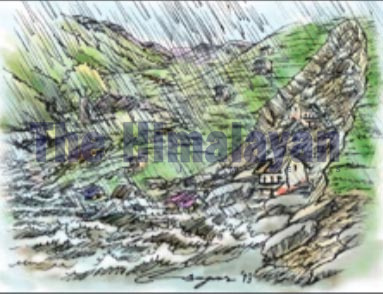Impact of monsoon rains: Lessons to be learned
National climate assessments predict increased climate variability. Agricultural productivity is declining due to degradation in soil fertility, raising the importance of conservation agriculture, about which farmers are unaware.
Nepal just went through a disastrous situation because of the unprecedented monsoon rains or, let’s say, precipitation of high intensity and low frequency, a scenario which is considered to be an impact of global warming and climate change.
Rivers as well as major cities, including the capital, Kathmandu, were flooded, and people, livestock and even standing crops were swept away by the floods. Although it was the monsoon rains, why did they create such havoc? Along with the fact that Nepal is highly vulnerable to natural disasters like floods, landslides and earthquakes because of its mountainous and fragile geology, recent incidences are, in fact, a clear case of natural-induced disasters with humans making some contributions.
Floods depend on many things, such as climate, nature of the stream, soil, vegetative cover, amount of snow melt and overall rainfall. It is important to understand the reasons behind the floods so as to mitigate the impact and plan management strategies for the future.
The first thing to understand is the ever increasing population and its pressure on the natural resources. The valleys of this mountainous country are already crowded with the ever-increasing population, making it difficult to find open spaces to house the people. The latest floods are the indirect cumulative impacts of environmental issues.
Since one of the main causes of a flood is poor natural drainage, unplanned urbanisation where construction activities have a feeble drainage system causes flooding in the cities. Unplanned land use change and improper infrastructure development have led to soil erosion and landslides.
Besides, the atmosphere is getting highly polluted. Global warming and climate change have great impact on developing nations, and Nepal ranks fourth in terms of climate vulnerability. Although it contributes negligible amounts of green house gases (GHGs), the risk of severe impacts is high because Nepal is a mountainous country with low mitigation capacity.
National climate assessments predict increased climate variability and frequency in disaster incidents. Agricultural productivity is declining due to degradation in soil fertility, raising the importance of conservation agriculture, about which most farmers are unaware. Every environmental issue has a number of direct and indirect impacts, which need to be identified before the implementation of any proposed project, but that is found to be overlooked in the Nepali context.
As during every monsoon, this time also the villages along the Nepal-India border got inundated, creating loss of many lives and submerging large tracts of land. However, the issue becomes a matter of serious concern only when the floods are at their peak of destruction, but once the rains stop, the concern fades away. Despite some existing plans, policies and committees on disaster management, the government does not seem to be bothered about finding a lasting solution. Since it is the inhabitants along the border who must suffer, both the Nepali and Indian governments should find a concrete way out of the disaster.
Disaster preparedness has become a national priority with execution of the early warning system (EWS), especially in the case of floods: a system to alert the communities living near the rivers by sounding an alarm about the rising water levels in the rivers. It has been found to be effective in the major rivers to some extent. Coordination among the stakeholders, from government officials to the rural people, plays a major role in setting up an effective working mechanism for EWS. There must be a provision for monitoring and evaluating the works to be carried out by every responsible stakeholder. We must now try to set up an EWS in the smaller rivers too so as to make every vulnerable community safe and secure.
Since rains trigger landslides, and Nepal being a country of hills and mountains, incidences of landslides are common here. And cumulative impacts of floods and landslides have multiplier effects on every component of the environment, ranging from soil to human life and the economy. So with the start of the monsoon or in the pre-monsoon phase, the government must carry out the required trainings and create awareness among the people who are vulnerable. The government could mobilise different government and non-government organisations in all parts of Nepal so as to make the community disaster-resilient.
To be safe and secure during the monsoon and manage flood events, the necessary actions should be accomplished during the pre-monsoon stage. Do the government and organisations working in this sector implement actions this way? Has the hydro meteorological data been used for flood forecasting activities on a regular basis? Or is there a dearth of experts in disaster management? It is indeed high time to ponder over these aspects.
Along with embankment construction and EWS, if such activities are carried out in time, then the loss could be lessened, and continuous efforts could lead to a lasting solution. Being a disaster-prone country, Nepal also needs proactive disaster management acts and policies, where policy on protection of accessible spaces or appropriate land use change should be an integral part. And effective implementation always matters.
Rijal is assistant professor at Agriculture and Forestry University, Rampur.






